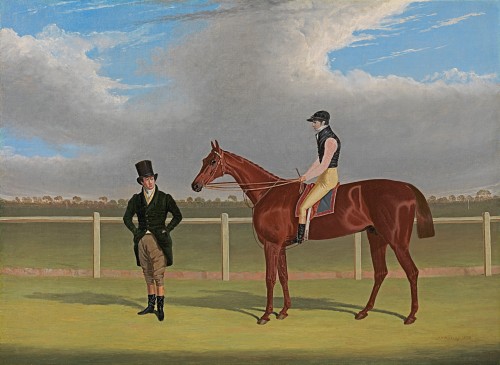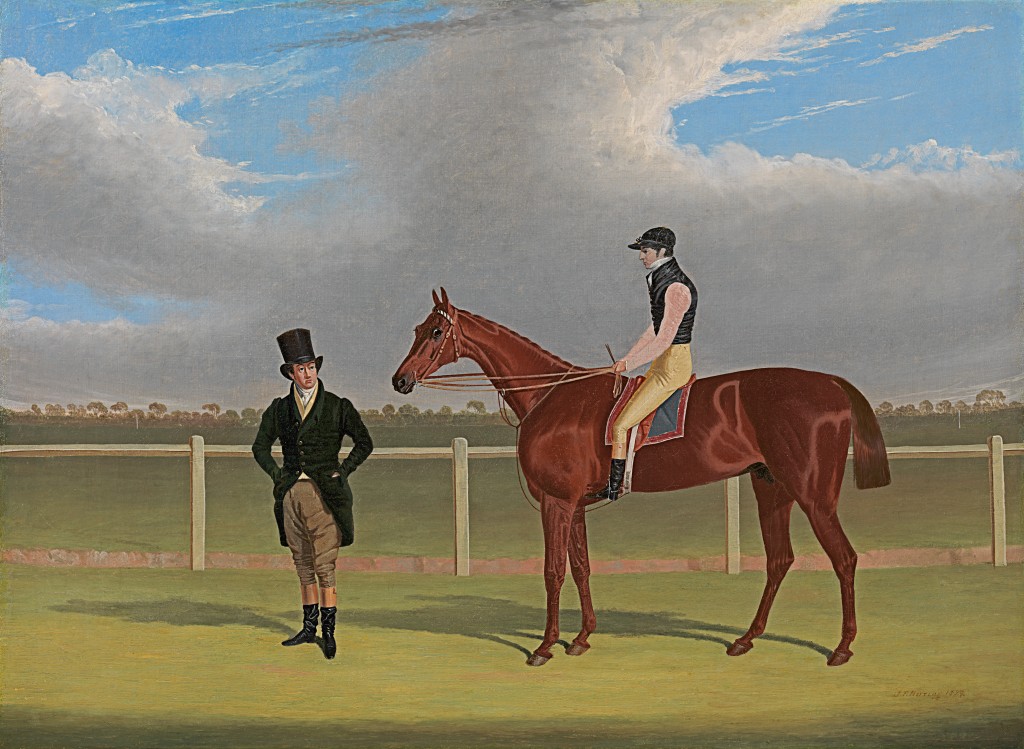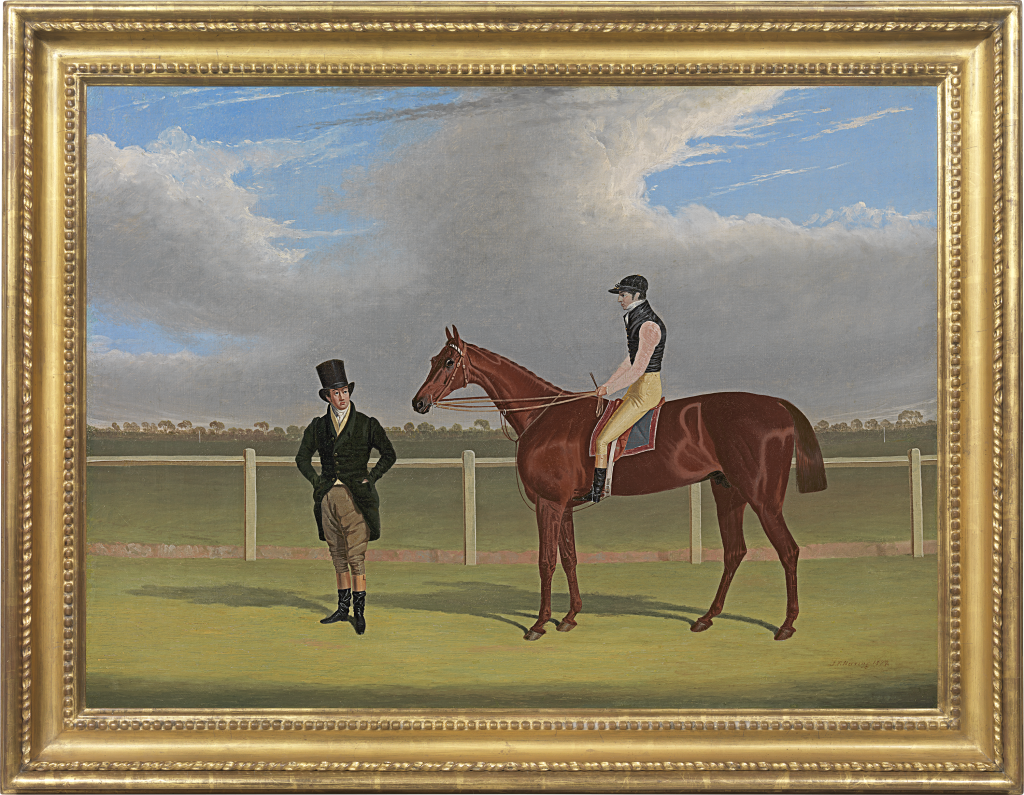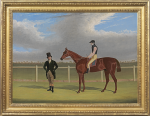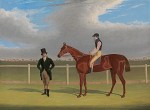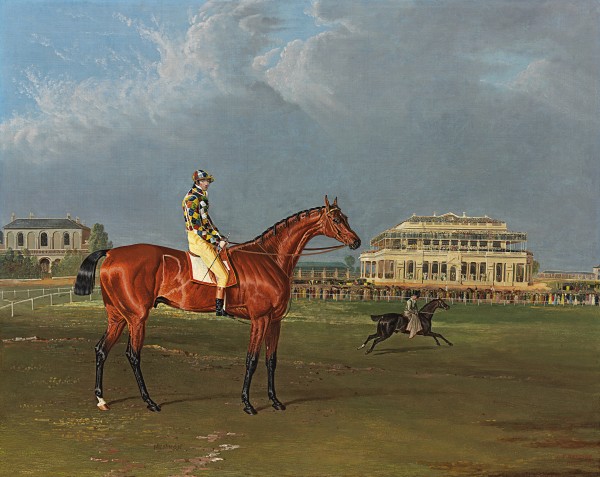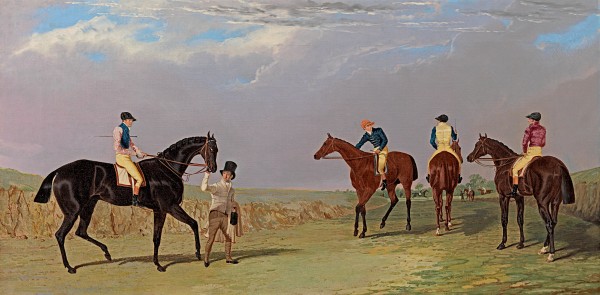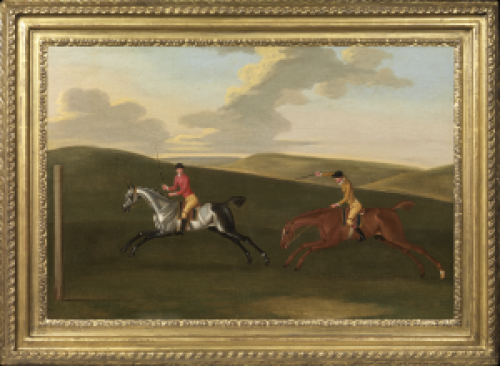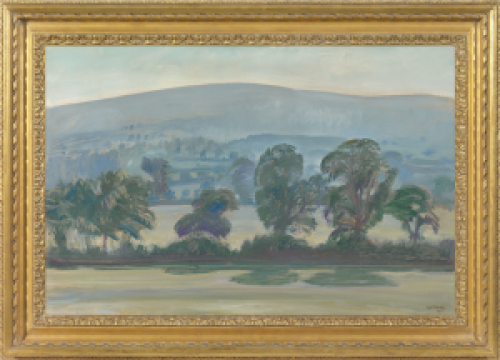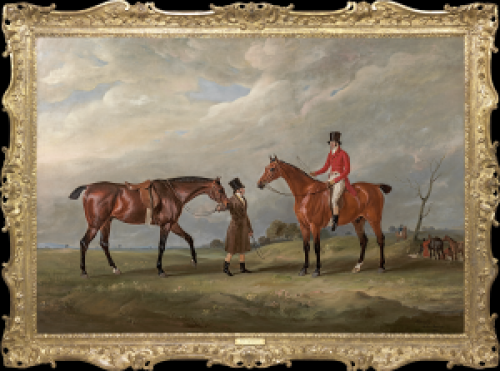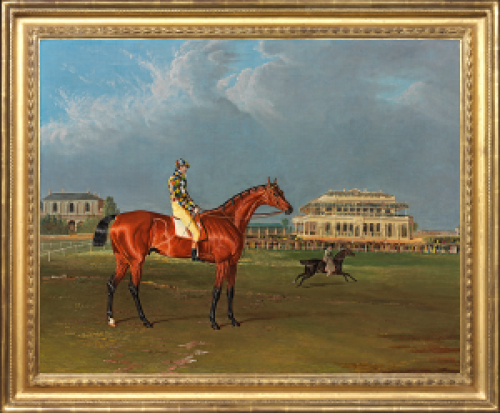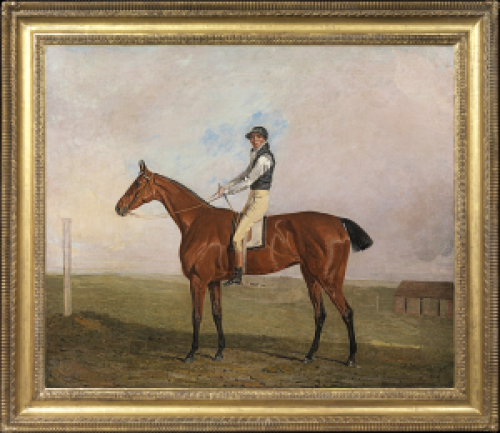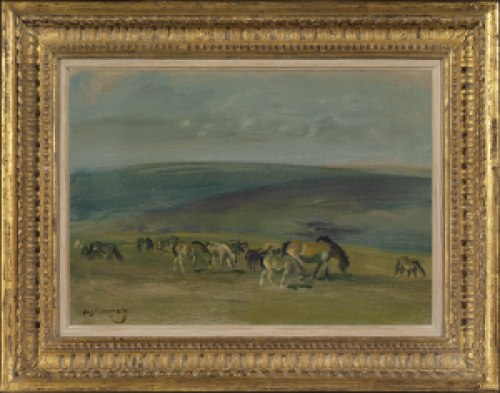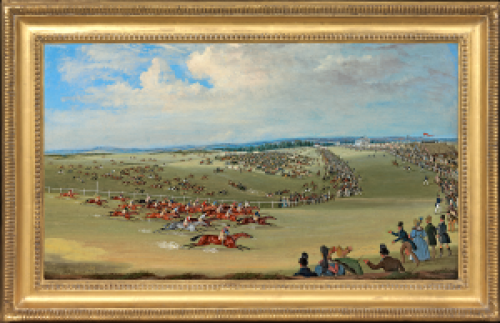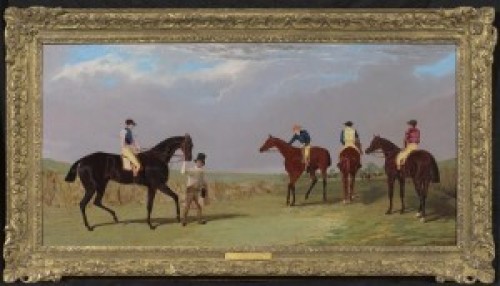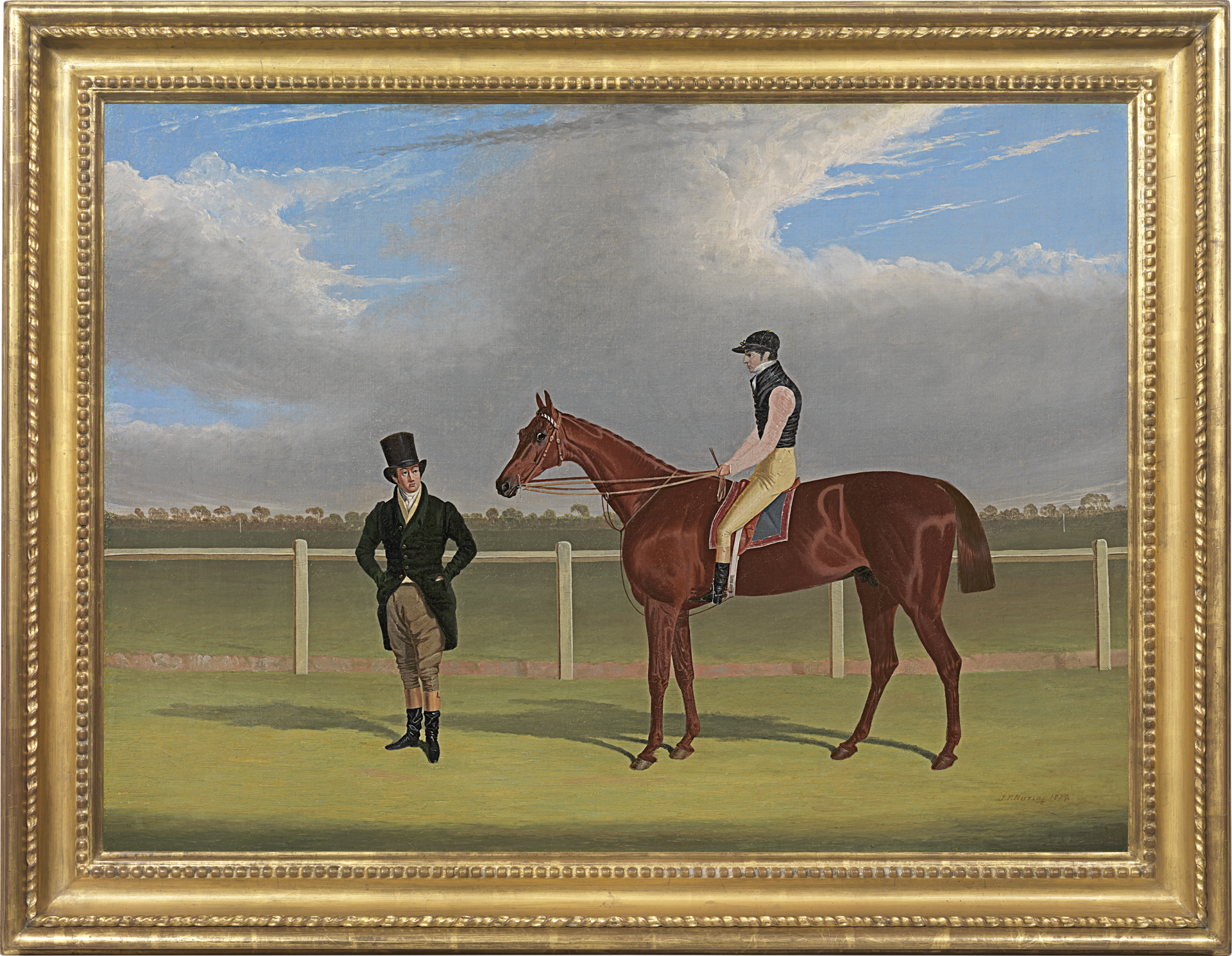JOHN FREDERICK HERRING SNR
Surrey 1795 - 1865 Meopham Park, Kent
Ref: CB 192
The Hon. Edward Petre's chestnut colt Rowton, winner of the 1829 Doncaster St Leger, with William Scott up and a trainer
Signed and dated lower right: J.F. Herring 1829
Oil on canvas: 22 1/8 x 30 1/8 in / 56.2 x 76.5 cm
Frame size: 26 ½ x 34 ½ in / 67.3 x 87.6 cm
In an English eighteenth century style hollow frame
Provenance:
Archibald Philip Primrose, 5th Earl of Rosebery (1847-1929), Dalmeny House, Scotland and The Durdans, Epsom;
his daughter Lady Sybil Grant (1879-1955), The Durdans, Epsom, Surrey
Sotheby’s London, 10th June 1988, lot 110;
private collection, USA
Exhibited:
New York, Frank Partridge and Sons, Fine English Sporting Paintings, 1959, pp.13-14, illus. (as Rowton with jockey up)
London, Frank Partridge and Sons, Sporting Paintings, 1st November-3rd December 1960, pp.18-19, no.39, illus. (as Rowton with jockey up)
Literature:
The Connoisseur, London, October 1960, p.iii (as Rowton with jockey up)
Rowton, by Oiseau out of Katherina, was foaled in 1826. He was owned by the Hon. Edward Petre of Stapleton Park, Yorkshire, scion of an old Catholic family which also owned Ingatestone Hall in Essex. He eventually bankrupted himself through his enthusiasm for the Turf, but not before chalking up many winners. In 1827, Petre’s filly Matilda had won the St Leger in a legendary duel with the prizefighter John Gully’s Mameluke, preserving the honour of the North of England against a Southern pretender.
Rowton won a sweepstakes of £440 at a York meeting in 1828. The following year, he started at 7 to 2 against in the Doncaster St Leger. This was the fourth running of the St Leger at the shorter distance of 1 mile, 6 furlongs, 132 yards[1]. Among the spectators crammed into the elegant new stand was the victor of Waterloo, the Duke of Wellington. Rowton’s jockey was the popular Yorkshireman Bill Scott, who notched up nine St Leger wins in his career.
The field of nineteen got away to a good start, at first bunched closely together. Rowton passed Parnassus, ‘taking the lead at a killing pace’[2]. He brushed off Sir Hercules and kept his lead easily until Sam Chifney Jnr on Lord Cleveland’s Voltaire, hanging back until the last minute as was his wont, challenged Scott. Despite Chifney’s lavish and characteristic application of the whip, Rowton was too strong for Voltaire and won by half a length. The prize was £2,425.
In 1830 Rowton won a 50 Sovereign Sweepstakes at Doncaster and the Great Subscription Purse and 200 Sovereigns at York in 1831. He was then sold to Sam Chifney’s trainer brother William. Ridden by Sam, he won the Oatlands Handicap at Ascot in 1832. He dead-heated with Camarine (who won the second heat) in the Ascot Gold Cup that year.
Note on the provenance
This painting was owned by a celebrated aficionado of the Turf, Archibald Philip Primrose, 5th Earl of Rosebery (1847-1929). It was said of him (probably apocryphally) that he had three ambitions: to win the Derby, to marry an heiress and to become Prime Minister. He won the Derby and became Prime Minister in 1894. In 1878 he had married Hannah de Rothschild, the richest woman in England, granddaughter of the banker Baron Nathan Mayer Rothschild.
Handsome and brilliant, Rosebery inherited his Earldom at the age of three, along with £30,000 a year and 21,000 acres of Scotland. He was sent down from Oxford for the sin of owning a racehorse. Rosebery’s immense fortune enabled him to form a superb art collection, including many sporting paintings, and maintain a stud at The Durdans, his mansion near Epsom. He won the Derby three times: with Ladas II in 1894, Sir Visto in 1895 and Cicero in 1905.
JOHN FREDERICK HERRING SNR
Surrey 1795 - 1865 Meopham Park, Kent
John Frederick Herring was the son of a London merchant of Dutch parentage, who had been born in America. The first eighteen years of his life were spent in London, where his greatest interests were drawing and horses. In 1814 he moved to Doncaster, arriving just in time to see the Duke of Hamilton’s William win the St. Leger. By 1815 he had married Ann Harris; his sons John Frederick Herring Junior, Charles and Benjamin were all to become artists, while his daughters Ann and Emma both married painters.
In Doncaster, Herring earned his living as a painter of coach insignia and inn signs and his contact with a firm owned by a Mr Wood led to his subsequent employment as a night coach driver. His spare time was spent painting portraits of horses for inn parlours and he became known as the ‘artist coachman’. Herring’s talent was quickly recognised and he soon found himself painting hunters and racehorses for the gentry.
In 1830, Herring left Doncaster for Newmarket, where he spent three years before moving to London. During this time, he may have received tuition from Abraham Cooper. In London, Herring got into financial difficulties and was rescued by W T Copeland, who commissioned many paintings including designs used for Copeland Spode bone china. In 1840-41, Herring visited Paris by invitation of the Duc d’Orleans, for whom he painted several pictures. In 1845, Herring was appointed Animal Painter to HRH the Duchess of Kent, followed by a commission from Queen Victoria, who was to remain a patron for the rest of his life.
Herring spent the last twelve years of his life at Meopham Park near Tonbridge, where he lived as a country squire. He now broadened his subject matter and painted agricultural scenes and narrative pictures, as well as his better known works of hunting, racing and shooting. A highly successful and prolific artist, Herring ranks with Sir Edwin Landseer as one of the most eminent animal painters of the mid nineteenth century. His paintings were very popular and many were engraved, including his thirty-three winners of the St Leger and his twenty-one winners of the Derby. Herring exhibited at the Royal Academy 1818-65, the British Institution 1830-65 and the Society of British Artists (whose Vice-President he became in 1842), 1836-52.
[1] Christopher McGrath, Mr Darley’s Arabian, London 2017, pp.114-115.
[2] Thomas Henry Taunton, Portraits of Celebrated Racehorses, vol. III, London 1888, p.52.

